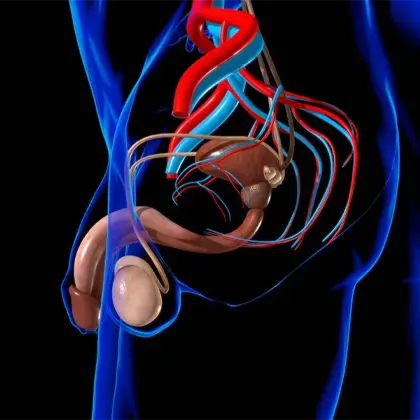Varicose veins in the testicles
Varicoceles: Time for Change
A varicocele is a congenital varicosity of the pampiniform plexus due to an absence of valves in the left internal spermatic vein. Approximately 10% to 15% of men have a left varicocele, which may cause pain, testicular atrophy, and be a cause of male infertility later in life. The condition is detected in as many as 40% of men undergoing an infertility workup and in remaining 50%, of Male Infertility the cause is not found. Spermiography may reveal decreased motility and, in some men, a slight decrease in sperm count.
Traditionally, the diagnosis was made through clinical examination; however, as with other venous reflux disorders, ultrasound has become the mainstay of diagnosis. For diagnosis, we look for abnormal reflux on color Doppler with the Valsalva maneuver, rather than the diameter and number of dilated veins with the patient in the standing position.
The Indications for treatment include infertility in patients with appropriate semen abnormalities, chronic groin pain, testicular atrophy in adolescent varicoceles, and recurrent varicocele after previous repair. Other indications more recently described with variable strength of evidence include low serum testosterone (with or without erectile dysfunction), and enhancement of assisted fertility techniques.


Varicoceles and Infertility
The presence of a varicocele alone is not an indication for treatment, infertility treatment should only be performed for men with appropriate semen abnormalities. The proof that varicocele repair improves fertility remains elusive; however, there is general acceptance that treatment does improve abnormalities of semen production. However, sperm counts greatly vary from day to day in any individual patient, and these measures correlate poorly with infertility outcomes. It has long been known that spermatozoa of infertile men possess substantially more chromatin defects and DNA damage than sperm of fertile men.
Preprocedure Preparation
First, scrotal ultrasound is performed on all patients.
Next, semen analysis is performed.
Alternative therapies are discussed, including no therapy or surgical therapy.
Informed consent is then obtained with the female partner in attendance.
Percutaneous VARICOCELE embolization
The catheter is manipulated into the left spermatic vein after Vascular Access . A varicocele is present if the contrast refluxes into the pampiniform plexus. If varicocele is confirmed, the spermatic vein is occluded, by injecting liquid embolics with or without metallic coils.
Postprocedure Care
The patient is kept in bed for 1 hour postprocedure. The patient is advised to take anti-inflammatory agents as needed and to avoid any activity involving the Valsalva maneuver, such as lifting, vigorous, or “hitting type” sports for 3 full days beginning the day after the procedure. Most patients report a minor dull ache in the back or groin lasting < 2 to 5 days. Fewer than 5% of patients will develop more severe pain lasting up to 14 days, requiring oral analgesics and anti-inflammatory agents and avoidance of vigorous exercise.
Varicocele embolization is safe and technically effective and achieves comparable results to surgery while offering the advantages of shorter recovery time, avoidance of general anesthetic, and patient preference.
Don’t let vein issues affect your life.
Book a call with us
Treatments for Varicose veins in the testicles
Venaseal Glue Treatment
- Can be performed in the office/outpatient environment
- Is relatively painless?
- Very little bruising of the leg
- Minimal local anaesthetic required.
- Return to work within 24 hours.
Radiofrequency Vein Ablation
- Gold standard treatment of varicose veins (along with endovenous laser ablation)
- Keyhole treatment
- Relatively painless and return to work within 24 hours
- Useful in treating primary varicose veins
Closure Treatment
- Same day procedure
- Fast recovery – resuming normal activities within 1-2 days
- Minimal or no scarring
EndoVenous Laser Ablation
- Keyhole treatment
- All varicose vein sizes can be treated.
- Relatively painless with return to work within 24 hours
- Useful in treating primary and secondary varicose veins
Ultrasound – Guided Foam Sclerotherapy
- Keyhole treatment
- Useful in treating recurrent varicose veins
- Outpatient/office based treatment
- Compliments: laser and radio frequency treatment of varicose veins
- Relatively cheap
Vein Check-up
- At the Vein and Foot Clinic, we offer an early detection service for the potential risk of developing thread veins, varicose veins, pelvic varicose veins, and deep vein thrombosis (DVT).
Conditions We Treat
- Varicose veins
- Superficial Venous Thrombosis Phlebitis
- Thread / spider veins
- Swollen leg
- Deep vein thrombosis (DVT)
- May turners syndrome
- Varicose veins in pregnancy
- Varicose veins in obese patients
- Restless leg syndrome
- Varicose veins of the testicles
- Recurrent Varicose Veins
- Hidden Varicose Veins
- Hemosiderin Brown Stains
- Lipo dermatosclerosis (LDS)
- Venous Eczema
- Leg Ulcers
- Vaginal and Vulval Varicose Veins
- Pelvic Congestion Syndrome (PCS)

